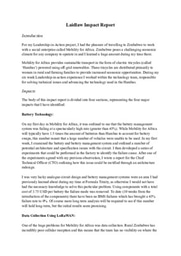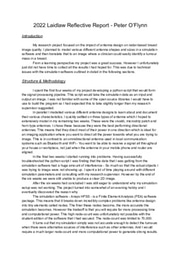Wireless Networks & Battery Management Systems: My LiA Impact Summary
Mobility for Africa provides sustainable transport in the form of electric tricycles (called Hambas) powered using off-grid renewables. These tricycles are distributed primarily to women in rural and farming families to provide increased economic opportunities. During my six week Leadership-in-action experience I worked within the technology team, responsible for developing solutions to issues faced by Hamba drivers and the company as a whole.
A summary of two of my most important impacts:
Reduction in the battery failure rate from 45% to 0%: On my first day in Mobility for Africa, it was outlined to me that the battery management system was failing at a spectacularly high rate. In my first week, I examined the battery and battery management system and outlined a number of potential architecture and specification issues with the circuit.
I then developed a series of experiments that could be performed in the factory to identify the failure cause. After one of the experiments agreed with my previous observation, I wrote a report for the Chief Technical Officer (CTO) outlining how this issue could be rectified through an architecture redesign.
Using components with a total cost of 3.75 USD per battery the failure mode was removed. To date (10 weeks from the introduction of the components) there have been no BMS failures.
Built a novel data collection network using the LoRa communication standard: I aided in the construction of a novel Telecommunication system using LoRa, a communication standard that uses license-free sub-gigahertz radio frequencies. Rural Zimbabwe has incredibly poor cellular reception so in order to collect data such as the location of the Hamba and battery State of Health (SOH) we had to create our own long range wireless network.
My role included aiding technicians in installing LoRa antennas and their accompanying hardware across mobility for Africa’s four major rural sites. I then developed software to translate the information collected from the LoRa network to their existing database and documented my code so it can be maintained in the future.
ODK (Open Data Kit) is an open-source toolkit for data collection. A typical ODK system comprises of a database and a number of users, who engage with the database through the ODK Collect App. This app (available on Android and iOS) allows the user to fill out and send forms back to a central database. In order for the app to integrate with the LoRaWAN communications network, I modified the source code of the ODK Collect App to create my own version. This version could detect if an external LoRa Antenna was connected and if there was no mobile data or wifi connection. The form information could then be parsed into a transmissible format and sent through the LoRa network.
What I learned during my six weeks:
Zimbabwe poses a challenging economic climate for any company to operate in. I learned a huge amount about how bureaucracy works in less-developed nations: Sometimes the best way to get something done is to simply sit outside someone's office. An example of this is when the team wanted to import electronic components. Although an online portal exists for filling out the necessary forms, the wait time is typically six months for approval. However, if you were to wait outside the secretaries office in the Ministry for Industry & Commerce, you could ask someone on their way out to sign the form for you. This is how the team could get approval for imports in a matter of hours. Having local knowledge such as this is incredibly important when building productive teams. While I feel like this may be more applicable to operating in less-developed countries, I think the same principle holds true: Local knowledge and connections are key.
In terms of technical learning, I spent quite a lot of time in the evenings researching areas I was not familiar with. These ranged from battery management systems to off-grid networks, to android application development. I found Udemy, an online e-learning platform especially useful when researching areas outside the typical scope of YouTube videos.
I came across many different leadership styles in Zimbabwe. I reported to the CTO who directed the engineering team. I found his method of using non-technical language and abstracting the problem away from the specific challenges to be quite interesting. This allowed the team to operate effectively in the sense that they had total control over the specific engineering decisions.
In conclusion, I was very lucky that I was able to align my LiA experience so closely with my technical skills. I believe this is what allowed me to have such a large impact in such a short space of time. The technical and leadership skills I developed on my LiA will stay with me long after I graduate the Laidlaw programme!



Please sign in
If you are a registered user on Laidlaw Scholars Network, please sign in